So many organisations and individuals involved in telecommunications continue to use the term 'exponential' to describe the growth in internet traffic, whether carried on fixed networks, or on wireless. Reports such as the ITU.M... forecast continued exponential growth until 2030 and there are numerous publications that cite growth following an exponential curve. But (with the possible expansion of the universe), nothing grows forever, let alone exponentially.
Let's consider the implications of exponential growth in internet data traffic. According to various sources, the amount of data transferred over the internet in 2018 will reach 1 Zettabyte (or 8x10²¹ bits). If growth continues exponentially at current rates (e.g. around a 50% year-on-year increase), the following things will happen: This is to say nothing of the electrical power requirements. Based on current future expectations of the energy required to transfer a bit of data (around 1 picoJoule per bit), by around 2080 we would need every single Watt of power generated on the planet Earth today to keep the Internet's lights on (let alone the problems of the sizes of batteries that would be needed in mobile devices). By 2113, we would need to capture every milliWatt of power that the Sun emits in order to power the Internet (in essence building a Dyson sphere). Slowly but surely the exponential growth in Internet traffic would begin to consume the whole universe.
This is to say nothing of the electrical power requirements. Based on current future expectations of the energy required to transfer a bit of data (around 1 picoJoule per bit), by around 2080 we would need every single Watt of power generated on the planet Earth today to keep the Internet's lights on (let alone the problems of the sizes of batteries that would be needed in mobile devices). By 2113, we would need to capture every milliWatt of power that the Sun emits in order to power the Internet (in essence building a Dyson sphere). Slowly but surely the exponential growth in Internet traffic would begin to consume the whole universe.
It is therefore to be hoped that the universe is actually infinite and continues to expand (though opinions on this are divided), otherwise it will run out of power before our insatiable demand for watching cat videos is finally sated.
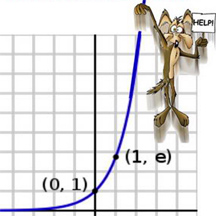 You might wonder what all this has got to do with radio spectrum, as there's always a Wireless Waffle angle on that topic. The simple fact is that although all the energy on the planet may be consumed keeping the Internet going, the amount of radio spectrum required to deliver the speed of connection necessary to transfer that much data will consume all available frequencies far before 2080. This is, of course, the desired goal of the mobile industry!
You might wonder what all this has got to do with radio spectrum, as there's always a Wireless Waffle angle on that topic. The simple fact is that although all the energy on the planet may be consumed keeping the Internet going, the amount of radio spectrum required to deliver the speed of connection necessary to transfer that much data will consume all available frequencies far before 2080. This is, of course, the desired goal of the mobile industry!
As Professor Albert Bartlett of the University of Colorado so aptly puts it:
Let's consider the implications of exponential growth in internet data traffic. According to various sources, the amount of data transferred over the internet in 2018 will reach 1 Zettabyte (or 8x10²¹ bits). If growth continues exponentially at current rates (e.g. around a 50% year-on-year increase), the following things will happen:
 By 2161, the number of bits of data transferred across the internet will equal the number of atoms in a human body.
By 2161, the number of bits of data transferred across the internet will equal the number of atoms in a human body.- By 2229, the number of bits of data transferred across the internet will equal the number of atoms in the planet Earth.
- By 2270, the number of bits of data transferred across the internet will equal the number of atoms in the Solar system.
- By 2329, the number of bits of data transferred across the internet will equal the number of atoms in the Milky Way galaxy (excluding dark matter).
 This is to say nothing of the electrical power requirements. Based on current future expectations of the energy required to transfer a bit of data (around 1 picoJoule per bit), by around 2080 we would need every single Watt of power generated on the planet Earth today to keep the Internet's lights on (let alone the problems of the sizes of batteries that would be needed in mobile devices). By 2113, we would need to capture every milliWatt of power that the Sun emits in order to power the Internet (in essence building a Dyson sphere). Slowly but surely the exponential growth in Internet traffic would begin to consume the whole universe.
This is to say nothing of the electrical power requirements. Based on current future expectations of the energy required to transfer a bit of data (around 1 picoJoule per bit), by around 2080 we would need every single Watt of power generated on the planet Earth today to keep the Internet's lights on (let alone the problems of the sizes of batteries that would be needed in mobile devices). By 2113, we would need to capture every milliWatt of power that the Sun emits in order to power the Internet (in essence building a Dyson sphere). Slowly but surely the exponential growth in Internet traffic would begin to consume the whole universe. It is therefore to be hoped that the universe is actually infinite and continues to expand (though opinions on this are divided), otherwise it will run out of power before our insatiable demand for watching cat videos is finally sated.
 You might wonder what all this has got to do with radio spectrum, as there's always a Wireless Waffle angle on that topic. The simple fact is that although all the energy on the planet may be consumed keeping the Internet going, the amount of radio spectrum required to deliver the speed of connection necessary to transfer that much data will consume all available frequencies far before 2080. This is, of course, the desired goal of the mobile industry!
You might wonder what all this has got to do with radio spectrum, as there's always a Wireless Waffle angle on that topic. The simple fact is that although all the energy on the planet may be consumed keeping the Internet going, the amount of radio spectrum required to deliver the speed of connection necessary to transfer that much data will consume all available frequencies far before 2080. This is, of course, the desired goal of the mobile industry!As Professor Albert Bartlett of the University of Colorado so aptly puts it:
The greatest shortcoming of the human race is our inability to understand the exponential function.
add comment
( 106 views )
| permalink
| 



 ( 2.8 / 954 )
( 2.8 / 954 )




 ( 2.8 / 954 )
( 2.8 / 954 )
Since his election as President of the United States, one of Donald Trump's key programmes has been the construction of a wall along the border with Mexico. Many people believe that the purpose of such a wall is to reduce illegal immigration along the border and to stop goods being illegally transported between the two countries without clearing the necessary customs.
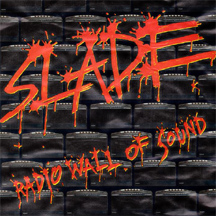 Wireless Waffle has discovered, however, that the reason for the construction of the wall is nothing to do with immigration or customs but is needed to prevent transmissions from mobile base stations using the 700 MHz band in Mexico from interfering with mobile base stations in the 700 MHz band in the USA.
Wireless Waffle has discovered, however, that the reason for the construction of the wall is nothing to do with immigration or customs but is needed to prevent transmissions from mobile base stations using the 700 MHz band in Mexico from interfering with mobile base stations in the 700 MHz band in the USA.
It is often said that radio signals do not respect international borders: signals from one country do not abruptly stop when they reach an arbitrary line on a map. As such, signals from mobile base stations in border areas are prone to cause interference to base stations on the opposite side of the border. Several European countries have reached an agreement (known as the HCM Agreement) which defines how much cross-border 'overspill' is permitted.
In general when signals cross borders, the use of the radio spectrum either side of the border is similar, that is to say that if the frequencies are used on one side for base station transmissions, it will be used on the other side for the same purpose. For example, if the signals from one country's mobile base stations are roughly the same strength along the border as those from its neighbour, and assuming that a mobile handset will latch onto the strongest signal, as it passes from one country to the next, it will automatically select the network for the country in which it is located.
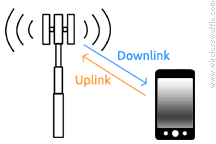 The worst case situation is where the transmitters on one side of the border (the 'downlink') which are typically 1000 Watts or more for a mobile base station are on the same frequencies as the receivers on the other (the 'uplink') which are trying to receive signals from mobile handsets with 1 Watt of power who are several miles away. This is akin to having someone in one country shouting directly into the ear of someone standing next to them who is simulatneously trying to hear one of their own residents whispering to them from a great distance. No manner of technological development will solve this problem and hence neighbouring countries try and avoid this happening.
The worst case situation is where the transmitters on one side of the border (the 'downlink') which are typically 1000 Watts or more for a mobile base station are on the same frequencies as the receivers on the other (the 'uplink') which are trying to receive signals from mobile handsets with 1 Watt of power who are several miles away. This is akin to having someone in one country shouting directly into the ear of someone standing next to them who is simulatneously trying to hear one of their own residents whispering to them from a great distance. No manner of technological development will solve this problem and hence neighbouring countries try and avoid this happening.
Between the US and Mexico in the 700 MHz band, however, this situation arises. The diagram below shows how the frequencies in this mobile band are used in either country. A downlink (mobile base station transmission) on the same frequency as an uplink (mobile base station receive) will cause exactly the kind of problems identified above.

So... the base stations in the 'lower 700 MHz band' in the USA will cause immense interference to the base stations in Mexico operating at the upper end of the Mexican 700 MHz band, and the base stations in Mexico will cause immense interference to the 'upper 700 MHz band' base stations in the USA.
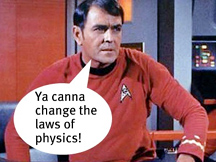 There is no straightforward solution to this problem, other than one or other country adopting the same frequency plan as its neighbour. As both countries already have services operating in the bands, this is beyond unlikely. The only way to overcome such a problem is therefore to try and stop signals from one side of the border reaching the other side. The laws of physics dictate that the only way to do this is to build a barrier that is impervious to radio signals, such as, for example, a tall metallic wall (or one with metal running up the inside). Metal boxes known as Faraday cages are used in laboratories (and sci-fi movies) to perform just this task.
There is no straightforward solution to this problem, other than one or other country adopting the same frequency plan as its neighbour. As both countries already have services operating in the bands, this is beyond unlikely. The only way to overcome such a problem is therefore to try and stop signals from one side of the border reaching the other side. The laws of physics dictate that the only way to do this is to build a barrier that is impervious to radio signals, such as, for example, a tall metallic wall (or one with metal running up the inside). Metal boxes known as Faraday cages are used in laboratories (and sci-fi movies) to perform just this task.

The 700 MHz band was sold at auction in the USA for US$19 billion in 2008. Estimates of the cost of the wall vary, but the mean value is around US$20 billion. This is no co-incidence. Having paid US$19 billion for the spectrum in the 700 MHz band, the US operators have a reasonable expectation that they can use the frequencies without undue interference and thus a 'Faraday Wall' is necessary. As long as Mr Trump can build it for less than US$19 billion, the operators will be happy, and the Federal Reserve will still have made a small profit on the sale of the spectrum. Win-win as they say.
 Wireless Waffle has discovered, however, that the reason for the construction of the wall is nothing to do with immigration or customs but is needed to prevent transmissions from mobile base stations using the 700 MHz band in Mexico from interfering with mobile base stations in the 700 MHz band in the USA.
Wireless Waffle has discovered, however, that the reason for the construction of the wall is nothing to do with immigration or customs but is needed to prevent transmissions from mobile base stations using the 700 MHz band in Mexico from interfering with mobile base stations in the 700 MHz band in the USA.It is often said that radio signals do not respect international borders: signals from one country do not abruptly stop when they reach an arbitrary line on a map. As such, signals from mobile base stations in border areas are prone to cause interference to base stations on the opposite side of the border. Several European countries have reached an agreement (known as the HCM Agreement) which defines how much cross-border 'overspill' is permitted.
In general when signals cross borders, the use of the radio spectrum either side of the border is similar, that is to say that if the frequencies are used on one side for base station transmissions, it will be used on the other side for the same purpose. For example, if the signals from one country's mobile base stations are roughly the same strength along the border as those from its neighbour, and assuming that a mobile handset will latch onto the strongest signal, as it passes from one country to the next, it will automatically select the network for the country in which it is located.
 The worst case situation is where the transmitters on one side of the border (the 'downlink') which are typically 1000 Watts or more for a mobile base station are on the same frequencies as the receivers on the other (the 'uplink') which are trying to receive signals from mobile handsets with 1 Watt of power who are several miles away. This is akin to having someone in one country shouting directly into the ear of someone standing next to them who is simulatneously trying to hear one of their own residents whispering to them from a great distance. No manner of technological development will solve this problem and hence neighbouring countries try and avoid this happening.
The worst case situation is where the transmitters on one side of the border (the 'downlink') which are typically 1000 Watts or more for a mobile base station are on the same frequencies as the receivers on the other (the 'uplink') which are trying to receive signals from mobile handsets with 1 Watt of power who are several miles away. This is akin to having someone in one country shouting directly into the ear of someone standing next to them who is simulatneously trying to hear one of their own residents whispering to them from a great distance. No manner of technological development will solve this problem and hence neighbouring countries try and avoid this happening. Between the US and Mexico in the 700 MHz band, however, this situation arises. The diagram below shows how the frequencies in this mobile band are used in either country. A downlink (mobile base station transmission) on the same frequency as an uplink (mobile base station receive) will cause exactly the kind of problems identified above.

So... the base stations in the 'lower 700 MHz band' in the USA will cause immense interference to the base stations in Mexico operating at the upper end of the Mexican 700 MHz band, and the base stations in Mexico will cause immense interference to the 'upper 700 MHz band' base stations in the USA.
 There is no straightforward solution to this problem, other than one or other country adopting the same frequency plan as its neighbour. As both countries already have services operating in the bands, this is beyond unlikely. The only way to overcome such a problem is therefore to try and stop signals from one side of the border reaching the other side. The laws of physics dictate that the only way to do this is to build a barrier that is impervious to radio signals, such as, for example, a tall metallic wall (or one with metal running up the inside). Metal boxes known as Faraday cages are used in laboratories (and sci-fi movies) to perform just this task.
There is no straightforward solution to this problem, other than one or other country adopting the same frequency plan as its neighbour. As both countries already have services operating in the bands, this is beyond unlikely. The only way to overcome such a problem is therefore to try and stop signals from one side of the border reaching the other side. The laws of physics dictate that the only way to do this is to build a barrier that is impervious to radio signals, such as, for example, a tall metallic wall (or one with metal running up the inside). Metal boxes known as Faraday cages are used in laboratories (and sci-fi movies) to perform just this task. 
The 700 MHz band was sold at auction in the USA for US$19 billion in 2008. Estimates of the cost of the wall vary, but the mean value is around US$20 billion. This is no co-incidence. Having paid US$19 billion for the spectrum in the 700 MHz band, the US operators have a reasonable expectation that they can use the frequencies without undue interference and thus a 'Faraday Wall' is necessary. As long as Mr Trump can build it for less than US$19 billion, the operators will be happy, and the Federal Reserve will still have made a small profit on the sale of the spectrum. Win-win as they say.
Back in December when we discussed the launch of Radio Caroline on 648 kHz and suggested that they were using wider bandwidth AM, Mike left a comment concerning Stereo AM. Stereo AM makes a great article for a post, so here we go!
AM broadcasting in the medium-wave (MW) band is traditionally mono only. Back in the early 1980's four competing technologies were running trials of AM stereo, and in 1988 a solution proposed by Motorola called Compatible-Quadrature Amplitude Modulation (C-QUAM) which had gained significant popularity, was chosen as the de-facto standard in the USA (it was formally adopted in 1993). The word 'compatible' refers to the fact that one of the primary criteria for the solution was that an 'old fashioned' mono AM receiver would not notice any difference when tuned to an AM-stereo signal, that is to say that it would continue to receive a mono signal as if nothing had changed. Thus the stereo signal would remain compatible with mono receivers (note that exactly the same is true of FM stereo).
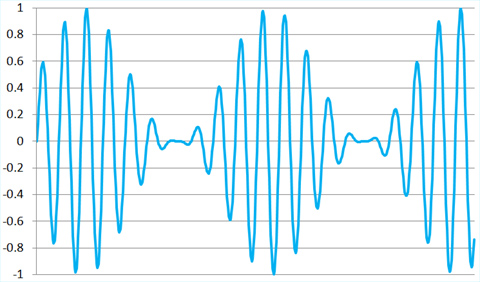 The C-QUAM solution used the properties of AM and of FM to do something novel. In an AM waveform (as shown on the right), the information (in this case audio) is imposed onto the transmission frequency (the 'carrier wave') by changing the amount of power transmitted, that is to say, changing the amplitude of the transmission and hence amplitude modulation (AM). At the receiver, only the amplitude of the signal is used to recover the data.
The C-QUAM solution used the properties of AM and of FM to do something novel. In an AM waveform (as shown on the right), the information (in this case audio) is imposed onto the transmission frequency (the 'carrier wave') by changing the amount of power transmitted, that is to say, changing the amplitude of the transmission and hence amplitude modulation (AM). At the receiver, only the amplitude of the signal is used to recover the data.
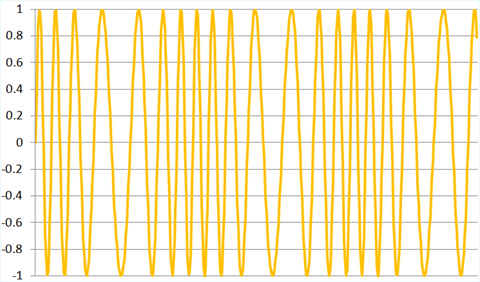 For an FM system, the amplitude or power of the transmitter remains the same and only the frequency is varied, hence frequency modulation (FM). In reality, the amplitude of the signal at the receiver will often vary, especially if the receiver is mobile, but as long as the signal that arrives at the receiver is strong enough to overcome any background noise, the receiver will still be able to detect what frequency was being transmitted and recover the original data or audio.
For an FM system, the amplitude or power of the transmitter remains the same and only the frequency is varied, hence frequency modulation (FM). In reality, the amplitude of the signal at the receiver will often vary, especially if the receiver is mobile, but as long as the signal that arrives at the receiver is strong enough to overcome any background noise, the receiver will still be able to detect what frequency was being transmitted and recover the original data or audio.
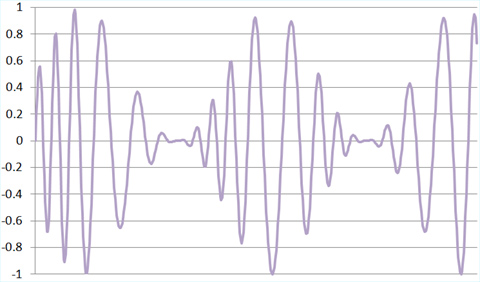 What Motorola did was to use both FM and AM at the same time. It is not as easy to see what is going on in the C-QUAM waveform shown on the right, but the principle is fairly straightforward. If you feed this signal into an AM receiver, it will only detect the changes in amplitude and will ignore the changes in frequency completely. If you feed this signal into an FM receiver, the opposite happens and the AM part of the signal is ignored and only the information modulated on the FM part of the signal is decoded. Hence you can send two sets of information at the same time, one using AM and the other FM.
What Motorola did was to use both FM and AM at the same time. It is not as easy to see what is going on in the C-QUAM waveform shown on the right, but the principle is fairly straightforward. If you feed this signal into an AM receiver, it will only detect the changes in amplitude and will ignore the changes in frequency completely. If you feed this signal into an FM receiver, the opposite happens and the AM part of the signal is ignored and only the information modulated on the FM part of the signal is decoded. Hence you can send two sets of information at the same time, one using AM and the other FM.
Compatibility is maintained by sending the Left and Right signals added together on the AM element of the transmission, and the 'stereo difference' (Left minus Right) on the FM part. Thus a mono AM receiver will see no change, but a stereo FM receiver will be able to add the mono and difference signals together to recover the original stereo signal. This is the same principle that applies for stereo FM broadcasting, though the method of transmitting the sum and difference signals are different.
The C-QUAM system is actually a little more complex than the description I have given above, for example, a pilot signal is added into the FM part of the signal to alert receivers that the transmission they are receiving is in C-QUAM, but the logic is in principle the same.
There are lots of videos of C-QUAM AM stereo on YouTube, but the one below is perhaps one of the best illustrations of what it sounds like on-air. It's actually fairly impressive.
So why is it that you've probably never heard of Stereo AM before? Here are some thoughts:
AM broadcasting in the medium-wave (MW) band is traditionally mono only. Back in the early 1980's four competing technologies were running trials of AM stereo, and in 1988 a solution proposed by Motorola called Compatible-Quadrature Amplitude Modulation (C-QUAM) which had gained significant popularity, was chosen as the de-facto standard in the USA (it was formally adopted in 1993). The word 'compatible' refers to the fact that one of the primary criteria for the solution was that an 'old fashioned' mono AM receiver would not notice any difference when tuned to an AM-stereo signal, that is to say that it would continue to receive a mono signal as if nothing had changed. Thus the stereo signal would remain compatible with mono receivers (note that exactly the same is true of FM stereo).
 The C-QUAM solution used the properties of AM and of FM to do something novel. In an AM waveform (as shown on the right), the information (in this case audio) is imposed onto the transmission frequency (the 'carrier wave') by changing the amount of power transmitted, that is to say, changing the amplitude of the transmission and hence amplitude modulation (AM). At the receiver, only the amplitude of the signal is used to recover the data.
The C-QUAM solution used the properties of AM and of FM to do something novel. In an AM waveform (as shown on the right), the information (in this case audio) is imposed onto the transmission frequency (the 'carrier wave') by changing the amount of power transmitted, that is to say, changing the amplitude of the transmission and hence amplitude modulation (AM). At the receiver, only the amplitude of the signal is used to recover the data. For an FM system, the amplitude or power of the transmitter remains the same and only the frequency is varied, hence frequency modulation (FM). In reality, the amplitude of the signal at the receiver will often vary, especially if the receiver is mobile, but as long as the signal that arrives at the receiver is strong enough to overcome any background noise, the receiver will still be able to detect what frequency was being transmitted and recover the original data or audio.
For an FM system, the amplitude or power of the transmitter remains the same and only the frequency is varied, hence frequency modulation (FM). In reality, the amplitude of the signal at the receiver will often vary, especially if the receiver is mobile, but as long as the signal that arrives at the receiver is strong enough to overcome any background noise, the receiver will still be able to detect what frequency was being transmitted and recover the original data or audio. What Motorola did was to use both FM and AM at the same time. It is not as easy to see what is going on in the C-QUAM waveform shown on the right, but the principle is fairly straightforward. If you feed this signal into an AM receiver, it will only detect the changes in amplitude and will ignore the changes in frequency completely. If you feed this signal into an FM receiver, the opposite happens and the AM part of the signal is ignored and only the information modulated on the FM part of the signal is decoded. Hence you can send two sets of information at the same time, one using AM and the other FM.
What Motorola did was to use both FM and AM at the same time. It is not as easy to see what is going on in the C-QUAM waveform shown on the right, but the principle is fairly straightforward. If you feed this signal into an AM receiver, it will only detect the changes in amplitude and will ignore the changes in frequency completely. If you feed this signal into an FM receiver, the opposite happens and the AM part of the signal is ignored and only the information modulated on the FM part of the signal is decoded. Hence you can send two sets of information at the same time, one using AM and the other FM.Compatibility is maintained by sending the Left and Right signals added together on the AM element of the transmission, and the 'stereo difference' (Left minus Right) on the FM part. Thus a mono AM receiver will see no change, but a stereo FM receiver will be able to add the mono and difference signals together to recover the original stereo signal. This is the same principle that applies for stereo FM broadcasting, though the method of transmitting the sum and difference signals are different.
The C-QUAM system is actually a little more complex than the description I have given above, for example, a pilot signal is added into the FM part of the signal to alert receivers that the transmission they are receiving is in C-QUAM, but the logic is in principle the same.
There are lots of videos of C-QUAM AM stereo on YouTube, but the one below is perhaps one of the best illustrations of what it sounds like on-air. It's actually fairly impressive.
So why is it that you've probably never heard of Stereo AM before? Here are some thoughts:
- Though a number of stations (particularly in the USA, Canada, Japan and Australia) did adopt the standard, there may have been insufficient stations on-air for consumers to properly experience the difference.
- The cost of receivers was always higher than mono ones as they were far more complex. This was exacerbated for a while as Motorola held the patents for the system and would have charged manufacturers a handsome fee to adopt it (they were forced to remove such payments in 1993 in the US when the FCC formally adopted the system).
- The quality of transmission of AM stereo, though better than AM mono, was not competitive with FM stereo which, by the time the C-QUAM standard had been adopted, were far more widespread than when the original AM stereo trials began.
- Maybe, and this is just supposition, the types of station on AM were in themselves less popular than the growing FM market, or possibly in some cases the programme material (e.g. talk) was not well suited to stereo.
Saturday 27 January, 2018, 09:04 - Spectrum Management, Much Ado About Nothing
Posted by Administrator
It seems that we, here at Wireless Waffle are having a bit of a spate of 'told you so' type events at the moment. Last month we spotted that Vodafone had been rapped over the knuckles for their crafty roaming fee shenanigans. Now we have spotted that Ofcom have been called out to assist drivers who couldn't lock or unlock their cars due to radio interference.Posted by Administrator
 On various occasions we have discussed how straightforward and relatively widespread the jamming of the frequencies used for your car keyfob is. Last time we discussed this it was because some miscreants had latched onto the idea and were stopping people locking their cars so that they could easily break in (more like stroll in) and take whatever they found in the glove compartments, foot wells and boots of the rich and not-so-rich.
On various occasions we have discussed how straightforward and relatively widespread the jamming of the frequencies used for your car keyfob is. Last time we discussed this it was because some miscreants had latched onto the idea and were stopping people locking their cars so that they could easily break in (more like stroll in) and take whatever they found in the glove compartments, foot wells and boots of the rich and not-so-rich. The Ofcom story is even more worrying as it suggests that jamming these devices is far easier than even we though possible. In addition to the car keyfobs we are so keen on discussing, the same frequency range (433 MHz) is also used for a wide variety of other wireless devices including wireless doorbells. These devices are relatively low power (10 milliWatts) and the idea is that they shouldn't interfere with each other as the range of transmission is very small. It seems, however, that a button on one such doorbell got stuck in the 'on' position, meaning it was constantly transmitting. This was enough to stop people in the vacinity locking and unlocking their cars. Thankfully, the brave Ofcom engineers were able to track down the problem and sanity was restored. Hurrah for Ofcom!
The Ofcom story is even more worrying as it suggests that jamming these devices is far easier than even we though possible. In addition to the car keyfobs we are so keen on discussing, the same frequency range (433 MHz) is also used for a wide variety of other wireless devices including wireless doorbells. These devices are relatively low power (10 milliWatts) and the idea is that they shouldn't interfere with each other as the range of transmission is very small. It seems, however, that a button on one such doorbell got stuck in the 'on' position, meaning it was constantly transmitting. This was enough to stop people in the vacinity locking and unlocking their cars. Thankfully, the brave Ofcom engineers were able to track down the problem and sanity was restored. Hurrah for Ofcom!Far be it for us to opine on the implications of this, but taking the earlier example from the BBC in which miscreants were jamming car locks but haven't Ofcom just provided these folk (and others with a similar inclination) with a simple, cheap and undetectable means of achieving the same outcome?
Just get hold of the push-button part of a wireless doorbell, put this in your pocket, and wander around a car park where posh cars park (maybe even buy a hi-viz jacket so it looks as if you are meant to be there). If it's a supermarket car park, collect a few trollies whilst you're waiting. When a particularly rich looking owner appears, go and stand close to their car and as they get out and get ready to press the button on their key to lock it, activate the wireless doorbell button. 'Hey presto', the car won't lock and you will be able to help yourself to their Gucci loafers and other luxury goodies.
From a radio spectrum management and perhaps more specifically a Wireless Telegraphy Act perspective, no law has been broken. From a Theft Act perspective, however, you still stand to be charged (or sit, depending on the layout of the court room).
Thanks Ofcom!

Posted using my gold-plated iPhone X, whilst wearing Gucci loafers and sipping Bollinger RD '85 on my luxury yacht moored in Saint Tropez with my 3 Aston Martins parked alongside.

